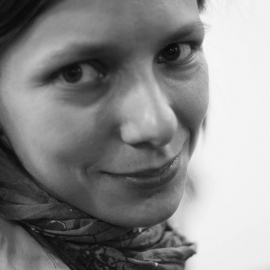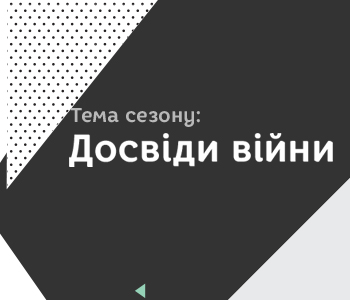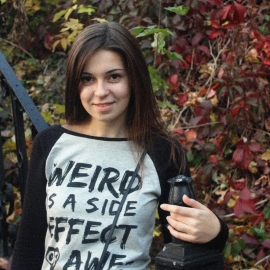Media scholars view gendered disinformation as “a subset of misogynistic abuse and violence against women, as false or misleading gendered and sexualized narratives, often with an intent and coordination to prevent women from participating in the public sphere and harm their reputation.”[1]
Gendered disinformation differs from general disinformation by violating women’s personal boundaries, promoting sexual and physical violence against women, etc. Therefore, gendered disinformation has multiple overlaps with rape culture, i.e., a culture in which sexual violence and other types of sexual abuse are normalized and embedded in a broader context. In such a culture, a woman’s sexual life and corporeality is either directly reduced to an object of male property or, through condemnation as immoral, is subject to attempts of social control, and thus also objectified.
See more about rape culture in the article by Evhenia Dyshleva
An example of gendered disinformation in Ukraine is the story of war correspondent Iryna Sampan. After she signed a statement by the NGO Women in Media against the Uncensored Calendar project (nude photography by Channel 5 journalists to raise funds for the army), Iryna was attacked by the right-wing radical group C14 and national russian pro-Kremlin media. The former tried to buy nude photos of her from her friends and sent negative messages about her to her husband, while the latter called her an “escort” and “Zaluzhny’s lover.”[2] In both cases, the mere existence of a woman’s sexual life was used to discredit her position and herself in order to intimidate and control her.
Such stories are seen not only in Ukraine. In 2021, fake nude photos of Foreign Minister Annalena Baerbock appeared in the German Internet segment.[3] In both cases, the fight against gendered disinformation should go beyond merely refuting fakes – it should foster the understanding of why the body and sexual agency belong to a woman only, the acceptance of different forms of sexual behavior, and dismantling the stereotypes of “female” and “male.” It is also important to counteract online and offline harassment at all levels and provide victims with comprehensive support.
However, gendered disinformation can also be viewed more broadly as the disinformation around feminism and related topics (LGBT+ rights), the instrumentalization of gendered narratives, or women themselves to advance political and other goals.
An example of such disinformation is the story of Olena Zelenska’s photo shoot for Vogue magazine. American conservative commentators reacted to it by spreading the idea that this photo session was funded by U.S. taxpayers and that it was a misuse of their money, and therefore, aid to Ukraine should be cut. In fact, U.S. aid comes as armaments, and the photo shoot was in no way related to that. Another, less obvious example was some Western feminists’ criticism of this photo session as glamorous and objectifying, on the sole basis that the photo was published in a glossy magazine. Even though there were no signs of objectification or other misogynistic aspects in the photos, as the first lady was in a subject position, in closed and formal clothes, in the setting of the presidential administration. However, a person who has not seen her, but has only read Western feminist criticism, may get a stereotypical (and false) impression. This is yet another example of gendered disinformation, although not malicious, but rather stemming from a dogmatic worldview and conviction of one’s truth despite the facts of reality.

Vogue cover with Olena Zelenska
Gendered disinformation can appear not only in the media but in other forms of public life, also. In 2018, the NGO Dukhovnist submitted a draft decision to a Brovary City Council session, which voted to appeal to the Verkhovna Rada [Parliament of Ukraine], the National Security and Defense Council, and other state institutions to remove from legal acts in education and from textbooks the norms and principles of sex education aimed at “overcoming gender stereotypes.” The appeal also called for a ban on “propaganda of various types of deviant sexual behavior,” in particular in the form of “so-called ‘equality marches,’ ‘pride parades,’ ‘gay parades,’ ‘queer culture festivals,’” etc. The reason for the appeal and the decision was the sex education project of Daryna Mizina, a Gender in Detail journalist who also worked with the local Brovary city media. The city council session interpreted the project as “encouraging sexual experimentation” and “promoting masturbation and homosexuality.”[4] The local media editorial office started receiving complaints about Daryna.
Gendered disinformation can target not only a certain woman, but also a group of women. russian (more often) and Ukrainian (less often) social media claim that since the beginning of the full-scale war, many Ukrainian women have moved abroad to engage in sex work, some brothels have opened with specifically Ukrainian women, this work is more desirable than other types of income, and Ukrainian women spread sexually transmitted diseases, but at the same time fill the state budget, which is not otherwise filled (“Zelensky sold Ukrainian women abroad”).[5]
Manipulating gender issues and promoting inequality is a constant component of far-right propaganda, as the entire patriarchal ideology is often an integral part of the far-right one. Emancipatory movements, such as socialism, liberalism, feminism, and the movement for the emancipation of the LGBT+ community, have been and are considered hostile by various versions of far-right and hatemongering ideologies. The strengthening of rape culture is a consequence of the spread of such ideologies, and gendered disinformation is their tool.
Far-right movements, patriarchy, male supremacy
The Third Reich considered family to be a genuine “cell” of the state. Ludwig Leonhardt, an expert in racial theory, argued that the family is a biological inheritance, and biological inheritance is the reproduction of the race. He authored “Marriage and Racial Hygiene,” which was promoted as a guide for proper marriage.
Another race theorist, Hermann Paul, believed that “free love” was detrimental to racial health. In general, the gender division in the culture of this era was extremely strong: the man held responsibility for all public affairs, and the woman, as the “keeper” of the family, was responsible for housework, raising children, and serving her husband’s needs.
The Nazis also defined standards for a woman’s body in reproductive and physiological terms: they discouraged decorative cosmetics, required women to conform to the standards of the Aryan race, and encouraged physical education and hygiene as a guarantee of reproducing a healthy race. Modern dances (jazz, etc.) were banned as encouraging women to become promiscuous.[6]
The famous far-right theorist of the first half of the 20th century, Julius Evola, considered men and women’s physical dimorphism to be a reflection of spiritual dimorphism. In his view, men and women had their own separate paths in life, and deviation from them was “a conflicting and unnatural way of being.” Manhood could be of two types: a warrior and an ascetic. Womanhood also had two types: a lover and a mother, and both of these types existed as subordinate to men (husbands and sons, respectively). Self-expression in these areas required a woman to forsake everything masculine in her personality, and a man, respectively, to forsake everything feminine. Evola linked all this to ancient traditional cultures, though indirectly, not in the ordinary sense of what should be borrowed from the traditional cultures for modernity, but rather in the spiritual and symbolic sense.[7]
Our contemporary, the known russian far-right political philosopher and propagandist Alexander Dugin, also did not miss an opportunity to comment on feminism. It is much more difficult to analyze him than previous thinkers, because his philosophy spans from an eclectic mix of very different ideas to a set of words that are only grammatically connected. Nevertheless, it can be deduced that he roots in the legend of the Great Mother, who was allegedly subdued by men, and now women are gaining strength again, and therefore humanity is facing such horrors as atheism, materialism, and progress.[8]
This is a vivid example of gendered disinformation and an unscientific approach, the promotion of a mythological worldview. On another occasion, Dugin generalized “LGBT+, perverted feral feminism, transgender people, wokeism, cancel culture, and the entire culture of the modern West” as “systematic demonization of the civilizational scale” and an illustration that “counter-initiation powers” have gained access to authority in Western Europe and the United States.[9] One should not look for any other meaning in this than incitement of hatred towards the West and all the mentioned groups and phenomena among all who know that demons are bad.
Another contemporary conservative thinker is the famous Canadian psychologist and bestselling author Jordan Peterson. In 2016, he participated in a local debate about transgender people on the conservative side, refusing to address people by their preferred pronouns. Peterson was manipulatively comparing transgender people and their allies to left-wing radicals, left-wing radicals to Nazis, and criticized Marxists and postmodernists as just along for the ride. As in Dugin’s case, there is no need to analyze this intellectual mess in detail, because its main purpose is to vent supremacists’ frustration, who feel the loss of male privilege and consider themselves to be affected by the emancipatory tendencies of society in general and by allegedly manipulative women in particular.
According to Peterson himself, 80% of his YouTube audience are young men.[10]

Jordan Peterson
In recent years, U.S. commentators have begun to distinguish male supremacy as a separate social phenomenon. Male supremacists advocate rigid gender roles and protest against feminism. While “ordinary” far-right movements have patriarchal views internal to their ideology, male supremacists focus specifically on the gender aspect.
The word “incel” (involuntary celibate) did not originate out of the male supremacist community, but it quickly spread there. The incel subculture’ worldview is based on the assumption that women choose attractive men and leave unattractive ones behind, which is expressed in a sharply misogynistic and coarse way. The subculture reduces the image of women to a lustful beneficiary who manipulates men for sex or money. Although this conventionally stereotypical woman has no interest in incels, they still consider themselves better than she is. In their ideology, there is a hierarchy among men, and women are basically below all levels of the male hierarchy.
This worldview paradigm fits neatly into the rape culture because it assumes that women’s attractiveness and sexual activity globally belong to men and are simply “unfairly” distributed among them, i.e., not in the way incels would like. Since women are not rushing to line up for the bearers of the misogynistic worldview, thus prolonging their celibacy, the view works like a self-fulfilling prophecy. This worldview also belongs to the conservative spectrum, because, according to incels, “before” (i.e., before the onset of feminism), the distribution of sexual “benefits” that women “bestowed” upon men was “fairer.” The incel ideology portrays its supporters as the “injured” party.[11]
There are no separate statistics on whether incels commit sexual crimes, but some hate crimes are associated with them, which links incels to the “ordinary” far right. In 2020, there was a terrorist attack in the German city of Hanau: the attacker killed nine people in several bars overnight, then returned home and shot his mother and himself. On his personal website, the 43-year-old terrorist published a manifesto in which, among other extreme racist statements, he said that he had never been intimate with a woman.[12] In the United States and Canada, people associated with the incel subculture have also committed several terrorist attacks that killed up to 50 people.
How russia is spreading conservative and violent narratives
The regime maintains the patriarchal attitudes of russian society at the level of both federal policy and local practices. A story in 2015 shocked russian feminists: in Chechnya, the head of the local police department forced a 17-year-old girl to marry him, even though he was three times her age and already had a wife. Ramzan Kadyrov himself attended the wedding, and the girl was led by his “right hand man” Magomed Daudov. Despite protests from feminists and the human rights community, the wedding took place, and nothing is known about the girl’s fate after. The Ombudsman for Children’s Rights verbally normalized this situation, in particular with the phrase “some women are wrinkled as early as 27,” which he later had to apologize for.[13] In Dagestan, such cruel misogynistic practices as female genital mutilation have spread in recent years, with more than a thousand girls undergoing this surgery every year.[14]

Forced wedding in Chechnya
In addition to reviving traditional patriarchal practices, there are new ones that are quite modern. The “male state” is a confirmed extremist movement, and it has been banned even in russia itself. This is a community of thousands of men, a vivid realization of rape culture, as it seeks to control women’s sexuality. These men publish photos of women without their consent to an audience of thousands, with mocking comments allegedly exposing “whores”, and private harassment, including threatening the women to send porn to their families. This movement is not only misogynistic, it also has a prominent racist focus: if a woman is suspected of having sex with a non-white man, and such suspicions are quite common for the movement, the extent of the abuse increases. For such women, they have coined a separate term: “inkwell.” The members of the “male state” call their ideology “national patriarchy.”[15]
After the full-scale invasion of Ukraine, the level of everyday, domestic, and sexual violence increased in russia itself. However, the media and russian psychologists do not associate the war of aggression and the rape of Ukrainian women with patriarchy, instead attributing the increase in aggression to war-related PTSD, thus justifying the violence.[16] This means that the forces that should counteract rape culture are infected with it.
russia’s patriarchal and conservative policies make it an attractive partner for far-right movements in other countries. Contrary to widespread perception, the Kremlin does not usually directly fund European far-right political parties. Rather, it is a win-win situation: for the world’s far-right, russia is a strong and influential country with a conservative regime. In turn, representatives of far-right forces act as “international experts” for domestic russian “consumption” and perform other useful roles, such as observers at illegitimate “referendums.” However, direct russian support can be found in the area of non-partisan cooperation, while media in different countries systematically pick up disinformation narratives favorable to russia.
Conservative family policy is a significant part of what russia exports abroad through disinformation narratives.
The World Congress of Families is a global network of organizations that oppose LGBT+ rights and abortion. It was founded in 1997 by American Christians and russians concerned about the demographic decline. It is believed to be funded by conservative russian oligarchs Konstantin Malofeev (who financed russia’s military intervention in Ukraine and is under numerous international sanctions) and Vladimir Yakunin.[17] In reality, the Congress operates as a tool of russian soft power, not only promoting patriarchal views on family and gender issues, but also spreading pro-russian political narratives. For many years, dozens of politicians from all over Europe have participated in WCF events, and in general, over 700 people from more than 50 countries have joined this network over the past 15 years.[18]
According to the former French representative of the WCF, Fabrice Sorlen, “this Europe of people and nations will replace a technocratic Europe with a more traditional European civilization; it will promote Christianity in a Europe hitherto dominated by the LGBT lobby. It must unite with Vladimir Putin’s russia to create a version of Europe that stretches from the Atlantic to the Pacific.”[19]
Conservative tendencies are spreading from russia to neighboring friendly countries. In Georgia, Levan Vasadze, a major real estate investor and former board member of a number of large companies in russia, known for his anti-immigrant, anti-liberal, and ultra-religious views, founded the Demographic Revival of Georgia Foundation, which is part of the WCF. In May 2021, Vasadze announced his official entry into politics as the founder of the “Unity, Essence, Hope” social movement. In the same year, he called on the government to cancel Tbilisi Pride, which was actually right-wing radicals violently interrupted.[20] A Moldovan President himself, Igor Dodon, patronized the 2018 WCF Congress in Chisinau.[21]
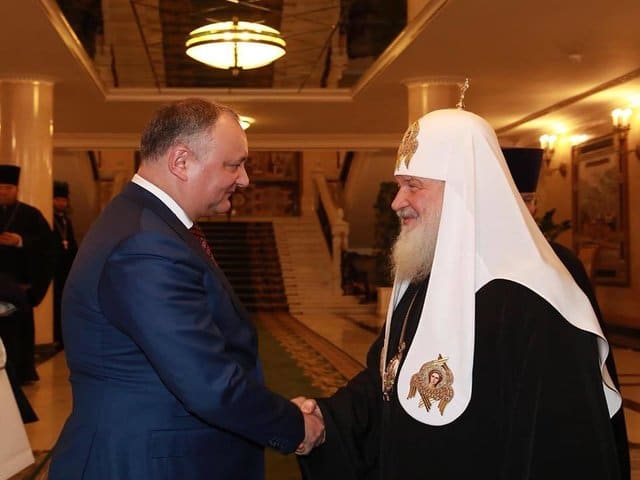
Moldovan President Igor Dodon meets with russian Patriarch Kirill
russian gendered disinformation in Ukraine
Research by the Ukrainian Women’s Fund shows that in Ukraine, the conservative part of society could also have received support from the russian Federation, and gendered disinformation was the channel of that support. Narratives benefitting russia were broadcast through affiliated structures (in particular, the Ukrainian Orthodox Church of the Moscow Patriarchate), the media, and other religious and conservative organizations and initiatives.
The researchers imply that in 2013, russia conducted a strategic information operation to prevent Ukraine’s European integration, which was supported by a tactical information operation to prevent the adoption of draft law No. 2342 (On Amendments to Certain Legislative Acts of Ukraine on Preventing and Combating Discrimination in Ukraine) and further expansion of the scope of the law “On Principles of Preventing and Combating Discrimination in Ukraine.” In the russian and Ukrainian media, similar narratives were observed. They were manipulating the concepts of “sexual orientation,” “non-traditional orientation,” “European values,” and “gender” as those that disrupt the family institution in Ukraine. There was also an attempt to form opinion with draft law No. 2342 and further expansion of the scope of the law “On Principles of Preventing and Combating Discrimination in Ukraine” as a step towards the dominance of fascist ideology in Ukraine (which is obviously not a fight against real fascism, but the use of an emotionally charged term to incite hatred).[22]
russian narratives in Ukraine did not stop after 2014. For example, in September-October 2015, Vitaly Milonov, a member of the St. Petersburg Legislative Assembly, unleashed a wave of discrimination against the LGBT+ community in the russian media. Simultaneously, narratives similar to Milonov’s (family values are the same as Christian values, the state must protect the family from the LGBT+ community, Ukraine – or russia for Milonov – stands strong in preserving traditional family values, etc.) spread in Ukraine with the common message “joining the EU will lead to the destruction of the family.”[23]
In 2021, a delegation of the Polish traditionalists Ordo Iuris visited the Verkhovna Rada Committee on Foreign Policy and Interparliamentary Cooperation aiming to convince them against ratifying the Istanbul Convention. Polish feminist activist Clementine Sukhanov conducted her own investigation and provided supporting documents that Ordo Iuris is indirectly funded by russian oligarch Konstantin Malofeev.[24] In Ukraine, the organization signed a memorandum of cooperation with Ruslan Kukharchuk’s conservative association All Together. [25] Kukharchuk’s other organization, Love Against Homosexuality, had been distributing leaflets as early as 2017 with not only conservative disinformation (the rights of LGBT+ people allegedly contradict human rights), but also with images of St. George’s ribbons on them (the ribbon is a russian military symbol). The organization Katechon took part in the same action. They borrowed the rare Greek word, which has no family or heterosexual connotations, from the think tank of the same name. This think tank is a joint project of the aforementioned Malofeev and Dugin.[26]
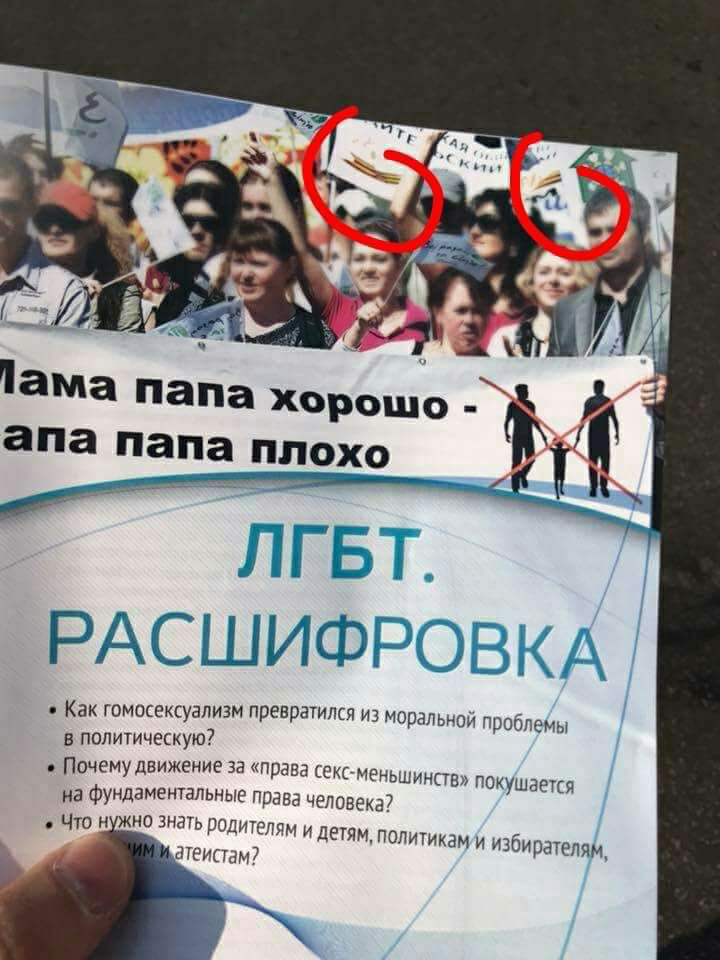
Leaflet of the organization “Love Against Homosexuality”
A news report about Ordo Iuris’ visit to Ukraine also bore signs of disinformation. It presented Ordo Iuris as “an independent legal organization based in Poland, accredited by the European Parliament... aiming to promote legal culture based on respect for human dignity and rights.”[27] In reality, it is a Polish branch of the international pseudo-Catholic movement Tradition, Family, Property (Tradição, Família e Propriedade), founded in Brazil in 1960, which allegedly promotes the “Catholic crusade.” In fact, it is not subject to the Vatican and has a history of extremism in Latin American countries (in particular, its members allegedly plotted to assassinate the Pope during his visit to Venezuela in 1984, after which the movement was banned in the country). In France, the TFP movement is considered a destructive cult (raising funds for unspecified purposes, obscure hierarchy and structure, and progressing requirements for members). The Canadian Bureau of Immigration and Refugees also lists TFP as a “religious paramilitary group.” The Vatican does not recognize this movement and is conducting an internal investigation into it (in particular, for using exorcism and rumors that all recent popes are controlled by the devil).[28]
Conclusion
To summarize, gendered disinformation is a practical tool for spreading rape culture and normalizing violent attitudes towards women and violence as such. Gendered disinformation can be disguised as “conservatism” or “family values,” but it does not lose its cannibalistic nature. russia was and is using gendered disinformation in various forms as part of its imperial propaganda, in particular by clogging the Ukrainian information space and supporting conservative movements and activists in our country and other countries.
After the russian federation’s full-scale invasion, Ukraine finally ratified the Istanbul Convention, and the prevalence of conservative narratives in the media and public space decreased. This can be explained by the fact that conservative activists have more important things to do and security services are working more effectively.
Photos: Annie Leibovitz for Vogue, Rene Johnston / Toronto Star / Getty Images, Radio Svoboda, Facebook page of Ihor Dodon, Zorian Kis
